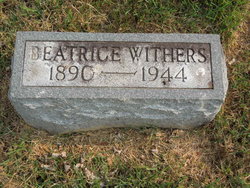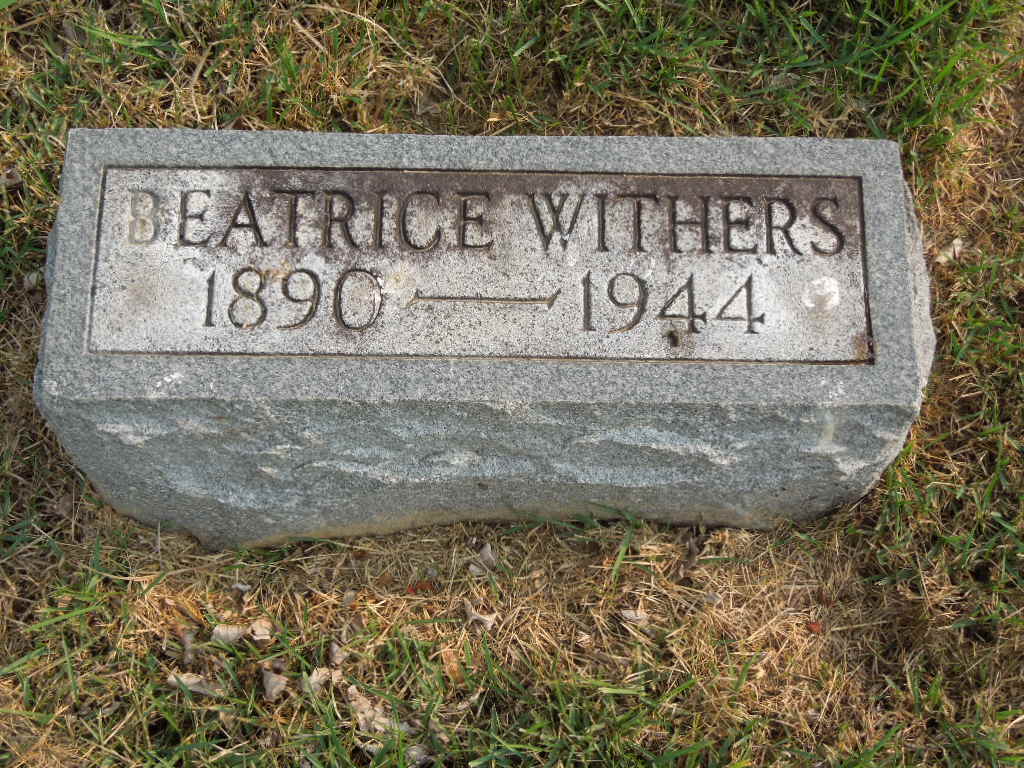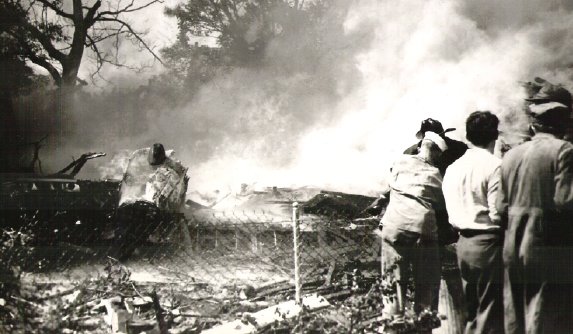Father: Thomas Jefferson Withers
Mother: Mary Ella Ratton
Single
She was an operator for Southern Bell Telephone Company.
"Accidentally burned to death when Army bomber fell on her home and exploded."
________________________________________________
By Vance Lauderdale, Memphis Magazine, June 2008
Just before 11 o'clock that morning, people in the vicinity of Poplar and Cleveland looked up when they noticed a U.S. Army B-25 bomber in distress. Some witnesses said the twin-engine plane actually flipped over and was flying upside down; others said the engines were sputtering or had quit completely.
W.D. Parr was standing outside a gas station on North Cleveland when he saw the plane falling from the sky. "I thought it was going to hit me," he told reporters. "I was running one way, then the other, trying to dodge it. The plane was zigzagging, seemed to straighten out for a second, then nosed almost straight down into a house."
The Commercial Appeal conveyed the horror of what happened next: "The brief staccato bark of a dying motor, a plane plummeting earthward, the terrible sound of impact, a dense cloud of black oil-smoke billowing skyward."
Piloted by a Memphian, Capt. Ralph Quale, the B-25 was on a training flight with just two other men aboard — Flight Officer Glenn Trickel of Memphis and Lt. Leon Kleinman of Dallas — when the engine failed minutes away from landing at Memphis Municipal Airport. The plane plunged within a hundred feet of Tech High School, and the pilot desperately tried to land in the parking lot behind Southern Bowling Lanes on Cleveland. By all accounts, Quale heroically steered the doomed aircraft away from residential areas, but it smashed into a two-story home at 222 North Claybrook behind the bowling alley.
As you can imagine, the scene was utter chaos. The newspaper described "a maelstrom of shouting, running people; of siren-screaming fire apparatus and ambulances; of semi-hysterical women; of grim-faced men who wanted to do something but couldn't."
The women had good reason to be "semi-hysterical." That house was occupied that morning, and everyone in it was killed instantly. The victims included 23-year-old Norman Cobb, his 22-year-old wife Naomi, their 2-year-old daughter Garlene, and another resident, 55-year-old Beatrice Withers. In an ironic twist, Cobb worked as an air traffic controller for the airport; he was home that morning because his shift didn't begin until 4 p.m.
Brave citizens managed to pull two bodies from the plane wreckage before it exploded in a fireball of gasoline flames and smoke. The first firemen on the scene showed up within minutes in unusual gear — baseball jerseys and cleats — because they had been playing a game at nearby Hodges Field against the Navy's Shore Patrol when they saw the crash.
Everyone that day talked about near-misses. Victim Beatrice Withers' sister, Mary, had just left the house to go to the bank; she was walking two blocks away when she heard the explosion. R.D. Pillow lived at 318 North Claybrook. "I heard a tremendous crash and the ground shook," he told reporters. "I ran to the window and saw the bomber crashed into the backyard of the house next door." Pillow's own home was scorched by fire. Two doors away, some young boys were climbing in a tree when the plane clipped the branches and crashed. "A piece of the plane hit me," said Francis Shepperd, showing reporters a gash on his leg, "and oil splashed on us. The plane fell all around us."
It took the fire department, aided by special chemical units from the airport, hours to quench the flames (above). No one ever determined the cause of the accident. The pilot never reported any problem with the airplane, and the B-25 had just been inspected and overhauled six days before. An officer with the Army's Accident Investigation Committee admitted, "I am as much at a loss as to the cause of the crash as the general public."
In the days that followed, more than 20,000 Memphians visited the crash site, and the Army brought in MPs to control the crowds. Although seven lives were lost, everyone breathed a sigh of relief that the plane had somehow missed Tech High, the Southern Bowling Lanes, Sears Crosstown, and dozens of nearby businesses that would have made the death toll much higher.
Today, there is no trace of the tragedy. The wrecked homes on Claybrook were rebuilt. Southern Bowling Lanes closed in the 1960s, though the building and parking lot remain. The seven victims were buried — Beatrice Withers in Forest Hill Cemetery here, the others in New York, Indiana, and Washington, D.C. And most people, it seems, have no memory of the worst aviation disaster in Memphis history.
Father: Thomas Jefferson Withers
Mother: Mary Ella Ratton
Single
She was an operator for Southern Bell Telephone Company.
"Accidentally burned to death when Army bomber fell on her home and exploded."
________________________________________________
By Vance Lauderdale, Memphis Magazine, June 2008
Just before 11 o'clock that morning, people in the vicinity of Poplar and Cleveland looked up when they noticed a U.S. Army B-25 bomber in distress. Some witnesses said the twin-engine plane actually flipped over and was flying upside down; others said the engines were sputtering or had quit completely.
W.D. Parr was standing outside a gas station on North Cleveland when he saw the plane falling from the sky. "I thought it was going to hit me," he told reporters. "I was running one way, then the other, trying to dodge it. The plane was zigzagging, seemed to straighten out for a second, then nosed almost straight down into a house."
The Commercial Appeal conveyed the horror of what happened next: "The brief staccato bark of a dying motor, a plane plummeting earthward, the terrible sound of impact, a dense cloud of black oil-smoke billowing skyward."
Piloted by a Memphian, Capt. Ralph Quale, the B-25 was on a training flight with just two other men aboard — Flight Officer Glenn Trickel of Memphis and Lt. Leon Kleinman of Dallas — when the engine failed minutes away from landing at Memphis Municipal Airport. The plane plunged within a hundred feet of Tech High School, and the pilot desperately tried to land in the parking lot behind Southern Bowling Lanes on Cleveland. By all accounts, Quale heroically steered the doomed aircraft away from residential areas, but it smashed into a two-story home at 222 North Claybrook behind the bowling alley.
As you can imagine, the scene was utter chaos. The newspaper described "a maelstrom of shouting, running people; of siren-screaming fire apparatus and ambulances; of semi-hysterical women; of grim-faced men who wanted to do something but couldn't."
The women had good reason to be "semi-hysterical." That house was occupied that morning, and everyone in it was killed instantly. The victims included 23-year-old Norman Cobb, his 22-year-old wife Naomi, their 2-year-old daughter Garlene, and another resident, 55-year-old Beatrice Withers. In an ironic twist, Cobb worked as an air traffic controller for the airport; he was home that morning because his shift didn't begin until 4 p.m.
Brave citizens managed to pull two bodies from the plane wreckage before it exploded in a fireball of gasoline flames and smoke. The first firemen on the scene showed up within minutes in unusual gear — baseball jerseys and cleats — because they had been playing a game at nearby Hodges Field against the Navy's Shore Patrol when they saw the crash.
Everyone that day talked about near-misses. Victim Beatrice Withers' sister, Mary, had just left the house to go to the bank; she was walking two blocks away when she heard the explosion. R.D. Pillow lived at 318 North Claybrook. "I heard a tremendous crash and the ground shook," he told reporters. "I ran to the window and saw the bomber crashed into the backyard of the house next door." Pillow's own home was scorched by fire. Two doors away, some young boys were climbing in a tree when the plane clipped the branches and crashed. "A piece of the plane hit me," said Francis Shepperd, showing reporters a gash on his leg, "and oil splashed on us. The plane fell all around us."
It took the fire department, aided by special chemical units from the airport, hours to quench the flames (above). No one ever determined the cause of the accident. The pilot never reported any problem with the airplane, and the B-25 had just been inspected and overhauled six days before. An officer with the Army's Accident Investigation Committee admitted, "I am as much at a loss as to the cause of the crash as the general public."
In the days that followed, more than 20,000 Memphians visited the crash site, and the Army brought in MPs to control the crowds. Although seven lives were lost, everyone breathed a sigh of relief that the plane had somehow missed Tech High, the Southern Bowling Lanes, Sears Crosstown, and dozens of nearby businesses that would have made the death toll much higher.
Today, there is no trace of the tragedy. The wrecked homes on Claybrook were rebuilt. Southern Bowling Lanes closed in the 1960s, though the building and parking lot remain. The seven victims were buried — Beatrice Withers in Forest Hill Cemetery here, the others in New York, Indiana, and Washington, D.C. And most people, it seems, have no memory of the worst aviation disaster in Memphis history.
Family Members
Sponsored by Ancestry
Advertisement
Advertisement









